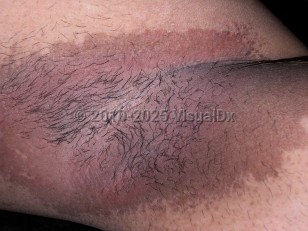Erythrasma
See also in: AnogenitalAlerts and Notices
Important News & Links
Synopsis

Erythrasma is a common, chronic superficial bacterial infection of the skin caused by Corynebacterium minutissimum. It is characterized by distinct, superficial hyperpigmented or erythematous patches localized to intertriginous areas, especially of the axillae, genitocrural crease, and interdigital web space of the toes. Lesions are often asymptomatic, although pruritus may be present, especially when it affects the genitocrural region. A "disciform" variant (large disc-like lesions) usually occurs outside of intertriginous areas and is associated with type 2 diabetes mellitus. Erythrasma may be acute or chronic. It may be asymptomatic or pruritic.
Obesity, diabetes mellitus, immunosuppression, a history of atopy, and hyperhidrosis are risk factors. All age groups may be affected, but incidence increases with age. The highest incidence is seen in regions of high humidity, especially in the tropics.
Obesity, diabetes mellitus, immunosuppression, a history of atopy, and hyperhidrosis are risk factors. All age groups may be affected, but incidence increases with age. The highest incidence is seen in regions of high humidity, especially in the tropics.
Codes
ICD10CM:
L08.1 – Erythrasma
SNOMEDCT:
238418005 – Erythrasma
L08.1 – Erythrasma
SNOMEDCT:
238418005 – Erythrasma
Look For
Subscription Required
Diagnostic Pearls
Subscription Required
Differential Diagnosis & Pitfalls

To perform a comparison, select diagnoses from the classic differential
Subscription Required
Best Tests
Subscription Required
Management Pearls
Subscription Required
Therapy
Subscription Required
References
Subscription Required
Last Reviewed:08/15/2019
Last Updated:08/15/2019
Last Updated:08/15/2019
 Patient Information for Erythrasma
Patient Information for Erythrasma
Premium Feature
VisualDx Patient Handouts
Available in the Elite package
- Improve treatment compliance
- Reduce after-hours questions
- Increase patient engagement and satisfaction
- Written in clear, easy-to-understand language. No confusing jargon.
- Available in English and Spanish
- Print out or email directly to your patient
Upgrade Today

Erythrasma
See also in: Anogenital
